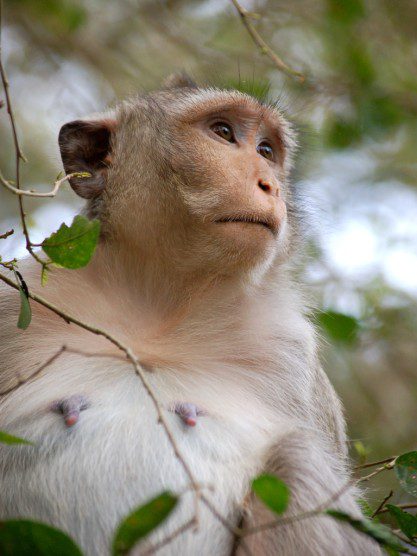U.S. primate import statistics for 2013

After four straight years of decline, the number of primates imported into the U.S. unfortunately increased by 8.5 percent over last year’s figure, according to preliminary data IPPL has been able to obtain from the U.S. Fish and Wildlife Service. Last year, according to revised data we received on April 8, 2013, the U.S. imported 17,448 primates. In 2013, the U.S. officially imported 18,934 apes and monkeys—1,486 more than in 2012.

Long-tailed macaques (a.k.a. crab-eating macaque monkeys) like this one are imported by the thousands into the U.S. every year for research purposes.
Species imported
Over 90 percent of the imported primates were crab-eating (a.k.a. long-tailed) macaque monkeys. They are widely used in the U.S. for toxicology testing and biomedical experiments. Year after year, this species tops the list of primate imports. As IPPL Executive Director Shirley McGreal noticed, “The pig-tailed macaque, once touted as THE model for AIDS research, has fallen out of favor, to the extent that none were imported in 2013.”
Only four apes (two gorillas and two siamangs) were brought in. The gorillas were transferred between zoos (Calgary to Dallas). The two siamangs were imported from the Dortmund Zoo in Germany to the Tanganyika Wildlife Park, near Wichita, Kansas. This facility is not currently accredited by the Association of Zoos and Aquariums. Siamangs are native to Southeast Asia; I wonder how they are enjoying winter in the American Midwest?
| Common Name | Scientific Name | Number | Percent |
| crab-eating macaque | Macaca fascicularis | 17,301 | 91.38 |
| rhesus macaque | Macaca mulatta | 1,255 | 6.63 |
| common squirrel monkey | Saimiri sciureus | 172 | 0.91 |
| common marmoset | Callithrix jacchus | 80 | 0.42 |
| green monkey | Chlorocebus sabaeus | 46 | 0.24 |
| vervet monkey | Chlorocebus pygerythrus | 16 | 0.08 |
| tufted capuchin | Cebus apella | 16 | 0.08 |
| black howler | Alouatta caraya | 10 | 0.05 |
| red-tailed monkey | Cercopithecus ascanius | 9 | 0.05 |
| mantled guereza | Colobus guereza | 9 | 0.05 |
| black-crested mangabey | Lophocebus aterrimus | 5 | 0.03 |
| gelada | Theropithecus gelada | 5 | 0.03 |
| Wolf’s mona monkey | Cercopithecus wolfi | 4 | 0.02 |
| western gorilla | Gorilla gorilla | 2 | 0.01 |
| weeper capuchin | Cebus olivaceus | 2 | 0.01 |
| siamang | Symphalangus syndactylus | 2 | 0.01 |
| TOTAL | 18,934 | 100 |
Primary countries of origin
China was again the single largest supplier of imported primates, a perennial source of surprise, since their chief export, the long-tailed macaque, is not native to China. Shirley points out that Indonesia and St. Kitts, both of which exported some hundreds of monkeys to the U.S. in 2012, did not send us any this past year. Another interesting absence: Laos, which has been setting up monkey capture and breeding centers; however, no monkeys reached us from Laos directly in 2013.
These countries supplied at least 100 primates to the U.S.
| Country | Number | Percent |
| China | 10,681 | 56.41 |
| Mauritius | 2,842 | 15.01 |
| Cambodia | 2,340 | 12.36 |
| Vietnam | 1,920 | 10.14 |
| Guyana | 189 | 1.00 |
Source of the animals
The reported number of wild-caught primates seems oddly low, and is likely not accurate. Similarly, says, Shirley, it is impossible to determine whether the number of “F1” animals (born in captivity to wild mothers) is true—or, for that matter, the number of captive bred animals.
| Source | Number | Percent |
| Wild caught | 433 | 2.29 |
| Born in captivity (F1+ generations) | 6,543 | 34.56 |
| Captive bred | 11,958 | 63.16 |
Primary ports of entry
These ports accepted at least 100 incoming primates each.
| Port | Number | Percent |
| Chicago, IL | 10,681 | 56.41 |
| Houston, TX | 5,580 | 29.47 |
| Los Angeles, CA | 1,381 | 7.29 |
| New York, NY | 1,197 | 6.32 |
Primary U.S. importers
These research facilities brought in more 500 monkeys each. Together, they accounted for 93 percent of all U.S. primate imports.
| U.S. Importer | Number |
| COVANCE RESEARCH PRODUCTS, INC. | 8,247 |
| SNBL USA, LTD. | 2,865 |
| CHARLES RIVER LABORATORIES, BRF | 2,691 |
| CHARLES RIVER LABORATORIES, RM HOUSTON | 2,490 |
| BUCKSHIRE CORPORATION | 626 |
| CHARLES RIVER LABORATORIES | 607 |
Primary foreign exporters
Each of these exporters sent the U.S. at least 500 monkeys.
| Foreign Exporters | Number |
| GUANGXI WEMEI BIO-TECH CO. LTD. | 3,600 |
| HUAZHENG LABORATORY ANIMAL BREEDING CENTER | 2,740 |
| BIOCULTURE MAURITIUS LTD. | 2,093 |
| TIAN HU CAMBODIA ANIMAL BREEDING RESEARCH CENTER LTD. | 1,820 |
| KHI BIO SERVICES C/O NAFOVANNY (NAFOVANNY C/O KHI BIOSERVICES LTD) | 1,440 |
| GUANGDONG BLOOMING SPRING BIOLOGICAL TECHNOLOGY | 1,076 |
| GUANGZHOU BLOOMING SPRING BIOLOGICAL TECHNOLOGY DEVELOPMENT | 860 |
| NOVEPRIM LTD. | 606 |
| SUZHOU JINNUO IMPORT & EXPORT CO., LTD. | 520 |
If you are interested in a complete copy of the 2013 data set, please contact the IPPL office (info@ippl.org).


Shame on you, these are Sentient beings, who feel all the things Humans do.
Very interesting!
This is a disgrace! Didn’t know the extent of animal cruelty that is going on in USA for the sake of science? Really? I’ll accept my life cycle fate in return to mitigate any more animal testing and experimenting. I can’t sleep at night now. I will become more active on this issue.